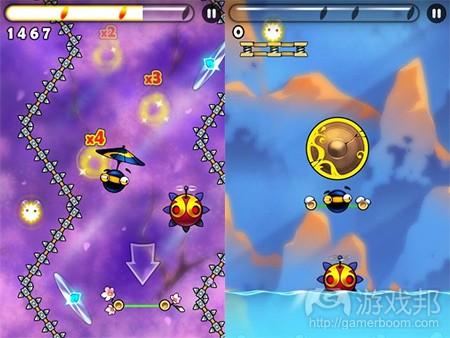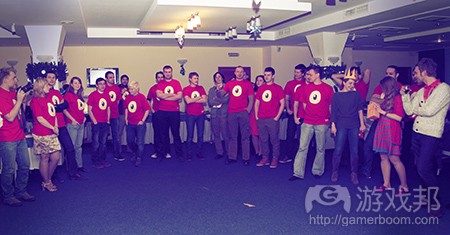Efim Voinov分享ZeptoLab创业经历及未来愿景
作者:Lee Bradley
俄罗斯出身的Voinov双胞胎兄弟的游戏生涯始于小时候玩的一台8位个人电脑ZX Spectrum。所以至今为止他们从事游戏制作已经超过20年了。
然而他们的事业顶峰直到创立了ZeptoLab才出现。益智游戏《割绳子》的风行使这家游戏公司一跃成为游戏界的闪亮人物。
在本文中,联合创始人Efim Voinov将介绍ZeptoLab如何建立、发展,最终成为“布丁怪兽”背后的游戏帝国。
ZeptoLab前身
Voinov兄弟的专业游戏开发经验源于他们的第一个工作室MuddyGlass。
就像ZeptoLab,MuddyGlass的成功是通过与平台商建立牢固的关系和充分利用市场扩张带来的机遇。
Efim解释道:“在2000年初,Palm操作系统才是手机操作系统市场的主宰。他们的掌上电脑简单又智能,所以价格公道的Palm m100一推出,我马上入手一台。 我们对开始新项目感到兴奋。我们发布了几款游戏和应用,小有成就—-其中一款游戏《Spy Chase 3D》是预装在Palm操作系统的智能手机上的,有几个美国学校还采用我们的动画制作工具Animator。”
一连串成功之后,Efim和Semyon又建立了Reaxion,这是一家专注于手机游戏开发和发行的公司。
Efim表示这段经历告诉他,良好的工作氛围、合适的工具和重视品质是运营一家成功的公司的必要条件。
正是这个经验使他在2009年萌生出单干的念头——建立ZeptoLab。当时Semyon仍在芬兰为Digital Chocolate工作。
关于《降落伞忍者》
Efim立即投入于ZeptoLab的第一款游戏,街机风格的物理益智游戏《降落伞忍者》。
在这款游戏中,玩家用橡皮筋帮助圆滚滚的主角——一个忍者越升越高,还可以用加速控制器操纵角色降落到其他橡皮筋上。
Efim回忆道:“在最初概念中,只有一条橡皮筋,用来将角色弹到目的地。我们的目标之一是使游戏的操作尽量直观,我们的创意来源于用手指弹橡皮筋。”
Efim对初期概念满意后,又决定采用亚洲主题的背景、以忍者为主人公。当时具体的玩法还没有完善。
“我们想出一个用绳子帮助主角上升的机制,索性将游戏的名字暂定为《悠悠球忍者》。之后,当我们让朋友玩这款游戏时,却发现绳子的玩法难度太大了。我们打算以休闲玩家为目标受众,所以就将绳子换成了更加直观的降落伞。”
这是明智之举。由Freeverse于2010年2月发行的《降落伞忍者》闯进iOS付费游戏排行榜的前十名,下载量突破300万。
《割绳子》的诞生
借助《降落伞忍者》的成功和Semyon的加入,ZeptoLab开始新的项目。
“尽管绳子在最终发行的《降落伞忍者》当中不管用,但在那之前我们已经花了很多时间研究绳子玩法的物理原理,希望能派上用场。之后我们开始考虑绳子机制还能怎么用,于是决定设计下一个项目的游戏时,就使用这个机制,最后就有了《割绳子》。”
在发布《割绳子》以前,ZeptoLab显然有所考虑。
Efim表示:“我的一个朋友以前从来不玩游戏,但当他拿到我们的游戏原型时,破天荒地不肯还我iPhone,直到他收集到所有星星。我认为这件事证明了我们的方向是正确的。”
“物理现象似乎很复杂,但其实对我们人类,无论是孩子还是成人来说都是很自然的事。我认为那就是物理游戏那么流行、那么受欢迎的原因。”
尽管如此,Efim仍然为Chillingo发行的《割绳子》的热门感到大大的惊讶。
“在几天以内,这款游戏就在大部分国家的应用排行榜中占据首位。显然,它大大超出我们的期望。”
《割绳子》的下载量如今已突破2亿5千万次。
再接再励
Efim认为,《割绳子》的售后支持是维持游戏成功的关键。
“我们总是在思考如何鼓励玩家返回游戏。通过不断发布新内容和特征,我们使游戏始终操持新鲜感和挑战性。这对我们的成功至关重要,因为它将玩家转变成忠实的粉丝。”
在《割绳子》首次发行的两年后,也就是2013年2月,这款游戏的最近更新使关卡数量达到325个。
在此之前,ZeptoLab还于2011年7月推出了自主发行版的《割绳子:实验》。尽管是原作的副产品,Efim认为《实验》仍然提供了全新的玩法。
“在开发过程中,我们的团队时不时地冒出许多创意点子,但不太适用于原版《割绳子》。所以当想法数量积累得差不多时,我们就着手开发《割绳子:实验》。我们把它当作一个拓展《割绳子》的机会,但同时保留玩家们喜欢的核心。”
当然,《实验》还帮助维持《割绳子》的人气,后者已经成为公司的一个赢利支柱。
不止是游戏
《割绳子》的核心就是一只绿色的小怪物Om Nom,喜欢吃甜食。
Om Nom“激发了玩家的父性本能”,是游戏界辨识度最高的吉祥物之一,这很大程度上归功于ZeptoLab对角色人气的挖掘。
Efim解释道:“在《割绳子》发布后的第一天,我们注意到玩家经常提出希望与Om Nom建立除了游戏体验之外更多的联系。这启发了我们以它为主题生产毛绒玩具、服装、桌面游戏和其他商品。”
ZeptoLab与Burger King合作,将Om Nom玩具介绍到快餐店中的儿童套餐。此外,ZeptoLab又与Sony合作将小怪物引入游戏机中。
现在,ZeptoLab已经不止是游戏开发工作室,更是一家娱乐公司。
扩张
随着利润的上涨,ZeptoLab的员工数量也显著增加,从最初的2名发展到2010年的近60名。
“首先,我们必须用更新支持我们的最初的iOS游戏,所以我们雇用了程序员、美工和游戏设计师。我们成功地发布《割绳子》的一连串更新后,首席执行官Misha Lyalin决定开始进一步拓展公司。我们的下一步是覆盖更多平台,所以在几个月的时间里,我们又组建了负责移植游戏的团队。”
就这样,ZeptoLab的员工人数在去年翻了一番,并且现在仍然处于“活跃的雇用状态。”
Efim表示,一开始应对公司越来越大的商业期望是“很困难”的,因为这需要ZeptoLab的资源所无法支持的注意力和机会。
“现在,情况好多了。我们的团队中有一些了不起的专业人员,帮助我们从商业的角度处理经营事务,所以我和Semyon可以将精力集中于开发工作。”
关于《布丁怪物》
这种精神显然体现在ZeptoLab的第二款自主发行的游戏《布丁怪物》之中。
这款游戏伴随着公司的成长壮大,是在公司的创意比赛中诞生的。通过这种比赛,公司鼓励员工分享他们的游戏概念。
不过,Efim和Semyon仍然参与了这款风格益智游戏的某些美术、程序和设计工作。
虽然《布丁怪物》的成功没有像《割绳子》那么大,但2012年12月发布后仍然高居世界各地排行榜前列。
对Semyon而言,《布丁怪物》的意义远远超过商业价值。
“在开发过程中,我们在内部框架中增加了跨平台的功能,这样游戏就能同时在iOS和Android上发布了。所以,从技术的角度说,这个项目对我们来说意义更大,尽管外行人可能不这么认为。通过这个项目,我们知道如何在之后的项目开发中提高速度和质量。”
未来
ZeptoLab在下一年的计划是,发布《割绳子》的新内容和几款新游戏,以及试水免费游戏市场。
公司发展到现在这么大的规模,是MuddyGlass时期的Semyon和Efim无法想象的。
Efim感慨道:“Semyon和我很幸运,正好赶上手机市场的黎明。看到如此巨大的变化和行业的未来走向,我们感到振奋。”
现在,Efim和Semyon将继续支撑ZeptoLab走在革新的前线。(本文为游戏邦/gamerboom.com编译,拒绝任何不保留版权的转载,如需转载请联系:游戏邦)
Om Nom and beyond: ZeptoLab, a studio profile
by Lee Bradley
Starting out at an early age toying around with a ZX Spectrum, the Russia-born Voinov twins have been making games for over two decades.
Yet it wasn’t until they founded ZeptoLab that the twins hit really big, building on the popularity of seminal puzzle title Cut the Rope to become one of the game industry’s leading lights.
In the latest of our company profiles, we speak to co-founder Efim Voinov about ZeptoLab’s early days, embracing expansion and creating an empire on the back of a sweet-toothed monster.
Learning the ropes
The Voinov brothers’ earliest experiences in professional game development came with their first studio, MuddyGlass.
Just like ZeptoLab, MuddyGlass would enjoy success by forging strong links with platform holders and capitalising on the possibilities offered by an expanding market.
“In the early 2000s, Palm OS was king of the mobile OS market,” says Efim.
“Their PDAs looked simple and smart, and once the affordable Palm m100 was released, I immediately got it. We were excited to start a new project.
“We released several games and apps, and managed to achieve some success – one of our games, Spy Chase 3D, was pre-installed on the Palm OS-powered smartphone, and several US schools adopted our animation creation tool, Animator.”
With independent success under their belts, Efim and Semyon took on roles at Reaxion, a mobile developer and publisher focusing on feature phone titles.
Efim says that the experience taught him that a good working atmosphere, the right tools, and a focus on quality over quantity are essential to running a successful company.
It was with this in mind that he would strike out on his own in 2009, setting up ZeptoLab while Semyon worked in Finland at Digital Chocolate.
Yo-Yos and parachutes
Efim immediately threw himself into the development of ZeptoLab’s first title, the physics-based arcade puzzler Parachute Ninja.
In the game you use slingshots to propel a spherical assassin into the air, using accelerometer controls to guide the character on his parachute-aided descent.
Parachute Ninja
“In the initial concept, there was only a single slingshot, which was used to launch the projectile toward the targets,” says Efim.
“One of our goals was to make the controls as intuitive as possible, and we came up with the mechanic of using your finger to slide the slingshot.”
Happy with this initial concept, Efim settled on an Asian-themed setting and a ninja protagonist, before looking to evolve the gameplay.
“We came up with a concept of a rope to help the hero navigate, and began calling the game Yo-Yo Ninja,” he says.
“Later, when we showed the game to our friends, it appeared that the mechanic of the rope was too difficult. We intended to target a casual audience, so we replaced it with the more intuitive parachute.”
It was a wise move. Published by Freeverse in February 2010, Parachute Ninja hit the top ten paid charts on iOS and would go on to rack up over 3 million downloads.
The next level
Buoyed by the success of Parachute Ninja and with Semyon leaving Digital Chocolate to join the fold, ZeptoLab began work on its next project.
“Although the rope didn’t make it into the final release of Parachute Ninja, we had spent a long time working on the physics of the rope mechanism to make it feel right,” says Efim.
“We started thinking about how else it could be applied, and decided to use the same engine when creating the game design for our next project, which turned out to be Cut the Rope.”
Even before release it was clear that ZeptoLab was onto something.
“I think the first indication that we were on the right path was when one of my friends who had never played games before got his hands on the prototype and didn’t return my iPhone until he had collected all the stars,” says Efim.
“Physics seems complicated, but it actually comes very naturally to us as humans – both children and adults. I think that’s why physics-based games are so popular and have such wide appeal.”
Despite all this, Efim was still massively surprised by the popularity of the Chillingo-published game.
“In a matter of a few days, the game climbed to the number-one spot in most countries, and it became clear that it had greatly exceeded our financial expectations,” he says.
To date Cut the Rope has been downloaded more than 250 million times.
The importance of support
For Efim, the post-release support for Cut the Rope has been a key part in the game’s continued success.
“We always think about how to encourage players to return to our games,” he says.
“By consistently delivering new content and features, we keep our games fresh and add more challenge for those who seek it. It’s critical to our success because it turns players into dedicated fans.”
ZeptoLab’s offices
Released in January 2013, over two years after the game’s initial release, Cut the Rope’s latest update takes the game’s tally of levels to 325.
In addition to this ZeptoLab also released the self-published Cut the Rope: Experiments in July 2011.
A spin-off from the main game, Efim identifies Experiments as a place to play around with novel new features.
“During development, our team occasionally came up with a number of great ideas that didn’t quite fit in the original Cut the Rope.”
“When the amount of ideas accumulated enough, we started developing Cut the Rope: Experiments.
“We saw Experiments as an opportunity to expand beyond what we had done with Cut the Rope, while keeping the core that our fans loved.”
And, of course, Experiments also helped maintain the visibility of what had become a hugely profitable franchise.
Not just games
At the heart of all of this is a little green monster with an insatiable taste for sweeties: Cut the Rope’s Om Nom.
Designed to “tap into the player’s paternal instincts,” Om Nom is one of the most recognisable mascots in the industry, due in no small part to ZeptoLab’s willingness to capitalise on the character’s popularity.
“In the first days after Cut the Rope went live, we noticed that people were frequently writing about their desire to have more connection with Om Nom beyond the digital experience,” says Efim.
“This inspired us to bring him to life in the form of plush toys, apparel, board games and other merchandise.”
Next up, says Efim, is a deal with Burger King to bring Om Nom toys to the fast food chain’s kids’ meals. And beyond that ZeptoLab is even working with Sony to bring an On Nom show to the small screen.
No longer just a game developer, ZeptoLab is now an entertainment company.
Expansion
Going hand-in-hand with this increase in interests, ZeptoLab has also significantly expanded its workforce, growing from two to almost 60 employees since 2010.
“First, we needed to support our initial iOS release with updates, so we hired a programmer, an artist and a game designer.
“Together, we managed to consistently update Cut the Rope, and started to further expand the company with our CEO, Misha Lyalin.
“The next step was to cover other platforms, so in the course of a few months we got a team onboard to start the porting process.”
Alongside this ZeptoLab has doubled its staff in the last year and even now is “currently in active hiring mode.”
The ZeptoLab team enjoy a classic ‘I said I was wearing that’ moment
Efim says that dealing with increased expectations from the business side of the company was “complicated” at first, as it brought attention and opportunities that ZeptoLab “lacked the resources to handle.”
“Now, the situation is much better,” he says.
“We have great professionals on our team who help us operate from a business standpoint, so Semyon and I don’t have to sacrifice our desire to stay in development.”
Sweet success
This desire was apparent during the making of ZeptoLab’s second self-published release, Pudding Monsters.
In keeping with the ZeptoLab’s expansion, Pudding Monsters was born of a company-wide ideas contest, in which staff were encouraged to share their game concepts.
Yet Efim and Semyon still chipped in with the some of the characterful puzzle game’s art, programming and design work.
Not the runaway hit that Cut the Rope proved to be, Pudding Monsters nevertheless enjoyed high chart positions across the world following its release in December 2012.
For Semyon Voinov, however, Pudding Monsters has greater significance beyond its commercial performance.
“During development, we added cross-platform capabilities to our internal framework, which allowed us to release the game both for iOS and Android simultaneously,” he says.
“So, on a technical side, this project is much more important for us than it might appear from the outside, in that it will help us to boost the development speed and quality of our upcoming apps.”
Beyond the monsters
The next twelve months promises fresh Cut the Rope content, a number of new games across fresh IP and the company’s first steps in the freemium market.
It’s the beginning of a hugely productive spell for the company, one that would have been scarcely conceivable during the early days of MuddyGlass.
“Semyon and I were lucky enough to start working at the dawn of the mobile industry,” says Efim.
“It’s exciting to see how vast the changes have been, and how much the industry continues to evolve.”
Now at the forefront of that evolution, it’s Efim and Semyon Voinov’s job to ensure that ZeptoLab can stay there.(source:pocketgamer)















































 闽公网安备35020302001549号
闽公网安备35020302001549号